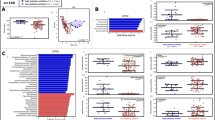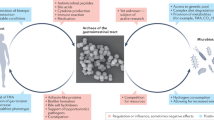Abstract
Purpose
We compared colonic methanogenesis in vivo and in vitro as well as fecal pH in healthy subjects and in patients with resected colorectal cancer thus without the possible confounding effects of the tumor.
Methods
A total of 144 subjects, 96 with resected colorectal cancer (of whom, 48 were with metastatic disease), 48 healthy subjects with intact colon, were analyzed for breath methane, fecal methanogenesis in vitro and fecal pH. In addition, the association between methanogenesis and pH with cancer site, operation technique and abdominal discomfort was investigated.
Results
In vivo and in vitro methane measurements were in agreement. The percentage of breath methane excretors and fecal pH did not significantly differ in participants resected for colorectal cancer, either with (46%, 6.76) or without (46%, 6.77) metastatic disease, from healthy participants (40%, 6.80). Breath methane excretors had higher fecal pH than nonexcretors (7.05 versus 6.57, P < 0.001) and less abdominal discomfort (30% versus 54%, P = 0.016). Among patients with resected right-sided cancer (n = 15), there were less breath methane excretors (20%) than among those with resected left-sided cancer (51%, n = 81, P = 0.029) as well as lower fecal pH than among those with resected left-sided cancer (6.27 versus 6.86, P = 0.002) and among healthy subjects (6.80, P = 0.010).
Conclusions
Patients with resected colorectal cancer were as frequently methane producers as healthy subjects with intact colon, and there was no difference in their fecal pH. Low methanogenesis was found in patients with abdominal discomfort and is a possible characteristic, along with low fecal pH, to right-sided colorectal cancer.

Similar content being viewed by others
References
Guarner F, Malagelada JR (2003) Gut flora in health and disease. Lancet 361:512–519
Candela M, Guidotti M, Fabbri A, Brigidi P, Franceschi C, Fiorentini C (2011) Human intestinal microbiota: cross-talk with the host and its potential role in colorectal cancer. Crit Rev Microbiol 37:1–14
Horz HP, Conrads G (2010) The discussion goes on: what is the role of Euryarchaeota in humans? Archaea. doi:10.1155/2010/967271
Chassard C, Scott KP, Marquet P, Martin JC, Del’homme C, Dapoigny M, Flint HJ, Bernalier-Donadille A (2008) Assessment of metabolic diversity within the intestinal microbiota from healthy humans using combined molecular and cultural approaches. FEMS Microbiol Ecol 66:496–504
Perman JA (1984) Methane and colorectal cancer (editorials). Gastroenterology 87:728–730
McGarr SE, Ridlon JM, Hylemon (2005) Diet, anaerobic bacterial metabolism, and colon cancer. J Clin Gastroenterol 39:98–109
Levitt MD, Furne JK, Kuskowski M, Ruddy J (2006) Stability of human methanogenic flora over 35 years and a review of insights obtained from breath methane measurements. Clin Gastroenterol Hepatol 4:123–129
Meyer J, Michalke K, Kouril T, Hensel R (2008) Volatilisation of metals and metalloids: an inherent feature of methanoarchaea? Syst Appl Microbiol 31:81–87
Michalke K, Schmidt A, Huber B, Meyer J, Sulkowski M, Hirner AV, Boertz J, Mosel F, Dammann P, Hilken G, Hedrich HJ, Dorsch M, Rettenmeier AW, Hensel R (2008) Role of intestinal microbiota in transformation of bismuth and other metals and metalloids into volatile methyl and hydride derivatives in humans and mice. Appl Environ Microbiol 74:3069–3075
McKay LF, Eastwood MA, Brydon WG (1985) Methane excretion in man—a study of breath, flatus, and faeces. Gut 26:69–74
Segal I, Walker ARP, Lord S, Cummings JH (1988) Breath methane and large bowel cancer risk in contrasting African populations. Gut 29:608–613
Haines A, Metz G, Dilawari J, Blendis L, Wiggins H (1977) Breath-methane in patients with cancer of the large bowel. Lancet ii:481–483
Piqué JM, Pallarés M, Cusó E, Vilar-Bonet J, Gassull MA (1984) Methane production and colon cancer. Gastroenterology 87:601–605
Gibson GR, Cummings JH, Macfarlane GT, Allison C, Segal I, Vorster HH, Walker AR (1990) Alternative pathways for hydrogen disposal during fermentation in the human colon. Gut 31:679–683
Newmark HL, Lupton JR (1990) Determinants and consequences of colonic luminal pH: implications for colon cancer. Nutr Cancer 14:161–173
Scharlau D, Borowicki A, Habermann N, Hofmann T, Klenow S, Miene C, Munjal U, Stein K, Glei M (2009) Mechanisms of primary cancer prevention by butyrate and other products formed during gut flora-mediated fermentation of dietary fibre. Mutat Res 682:39–53
Hughes R, Magee EA, Bingham S (2000) Protein degradation in the large intestine: relevance to colorectal cancer. Curr Issues Intest Microbiol 1(2):51–58
Pietroiusti A, Caprilli R, Giuliano M, Serrano S, Vita S (1985) Faecal pH in colorectal cancer. Ital J Gastroenterol 17:88–91
Kanazawa K, Konishi F, Mitsuoka T, Terada A, Itoh K, Narushima S, Kumemura M, Kimura H (1996) Factors influencing the development of sigmoid colon cancer. Bacteriologic and biochemical studies. Cancer 77:1701–1706
Ross LF (1987) Gas chromatographic technique to simultaneously quantitate the gases produced by intestinal microorganisms from fermentation mixtures. J Chromatogr 414:405–410
Ross LF, Shaffer GP (1989) Fermentation of carbohydrates under aerobic and anaerobic conditions by intestinal microflora from infants. J Clin Microbiol 27:2529–2534
Sivertsen SM, Bjørneklett A, Gullestad HP, Nygaard K (1992) Breath methane and colorectal cancer. Scand J Gastroenterol 27:25–28
Pitt P, De Bruijn KM, Beeching MF, Goldberg E, Blendis LM (1980) Studies on breath methane: the effect of ethnic origins and lactulose. Gut 21:951–959
Rana SV, Sharma S, Sinha SK, Kaur H, Sikander A, Singh K (2009) Incidence of predominant methanogenic flora in irritable bowel syndrome patients and apparently healthy controls from North India. Dig Dis Sci 54:132–135
Pye G, Evans DF, Ledingham S, Hardcastle JD (1990) Gastrointestinal intraluminal pH in normal subjects and those with colorectal adenoma or carcinoma. Gut 31:1355–1357
Hove H, Clausen MR, Mortensen PB (1993) Lactate and pH in faeces from patients with colonic adenomas or cancer. Gut 34:625–629
Abell GCJ, Conlon MA, McOrist AL (2006) Methanogenic archea in adult human faecal samples are inversely related to butyrate concentration. Microbial Ecol Health Dis 18:154–160
Flick JA, Perman JA (1989) Nonabsorbed carbohydrate: effect on fecal pH in methane-excreting and nonexcreting individuals. Am J Clin Nutr 49:1252–1257
Van Gorkom BAP, Cats A, Van Der Meer R, Kuipers F, Verschueren RCJ, Mulder NH, de Vries EG, Kleibeuker JH (1997) Effects of hemicolectomy on bile acid metabolism in relation to colon carcinogenesis in man. Eur J Clin Invest 27:589–594
Vernia P, Di Camillo M, Marinaro V, Caprilli R (2003) Effect of predominant methanogenic flora on the outcome of lactose breath test in irritable bowel syndrome patients. Eur J Clin Nutr 57:1116–1119
Grimble G (1989) Fibre, fermentation, flora, and flatus. Gut 30:6–13
Acknowledgements
We thank T. Poussa for helping with the statistics. This study was funded by Valio Ltd., Helsinki, Finland. There is no potential conflict of interest.
Author information
Authors and Affiliations
Corresponding author
Rights and permissions
About this article
Cite this article
Holma, R., Osterlund, P., Sairanen, U. et al. Colonic methanogenesis in vivo and in vitro and fecal pH after resection of colorectal cancer and in healthy intact colon. Int J Colorectal Dis 27, 171–178 (2012). https://doi.org/10.1007/s00384-011-1323-4
Accepted:
Published:
Issue Date:
DOI: https://doi.org/10.1007/s00384-011-1323-4




